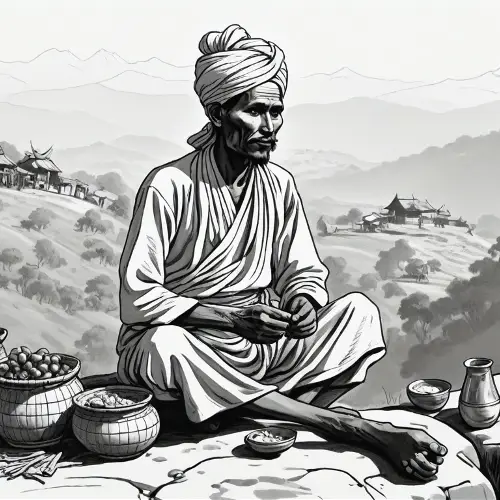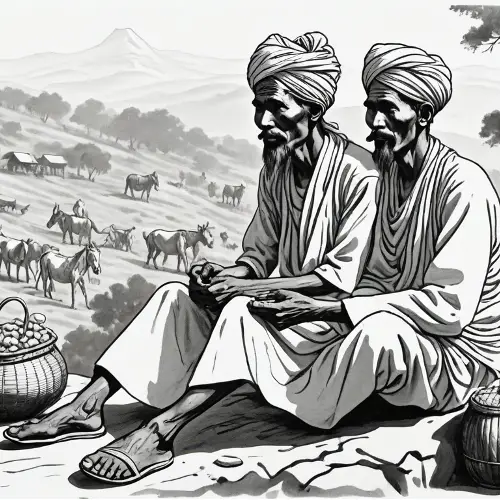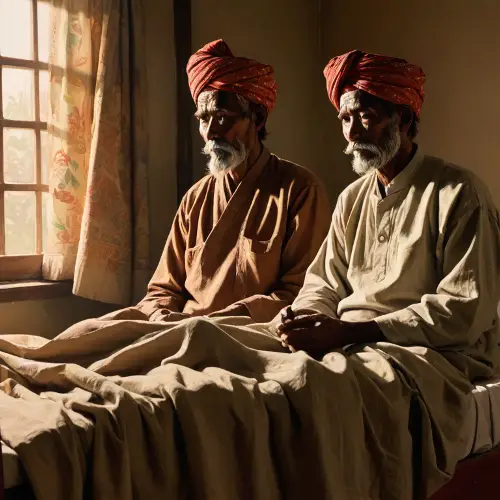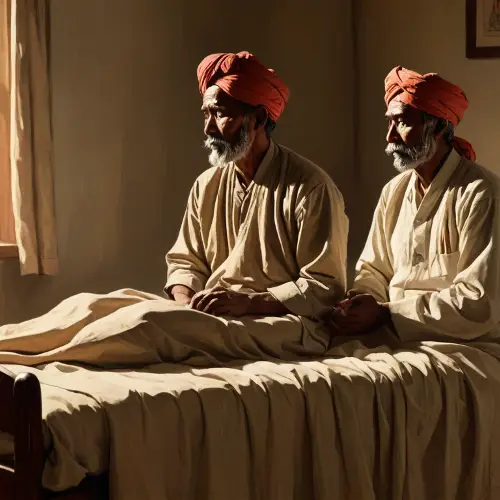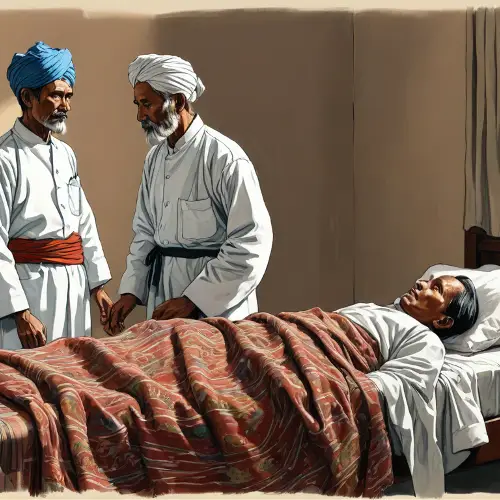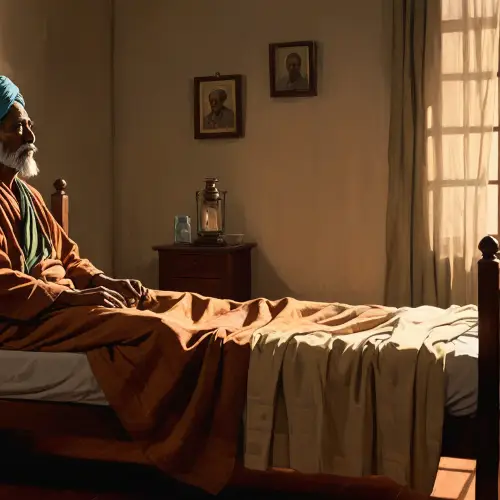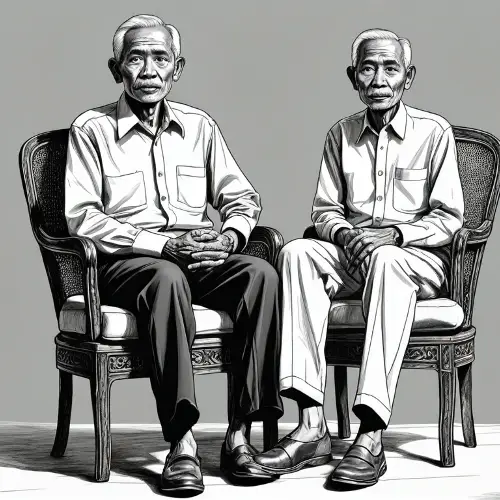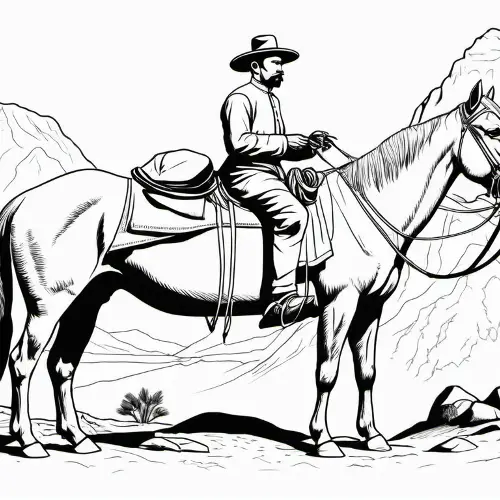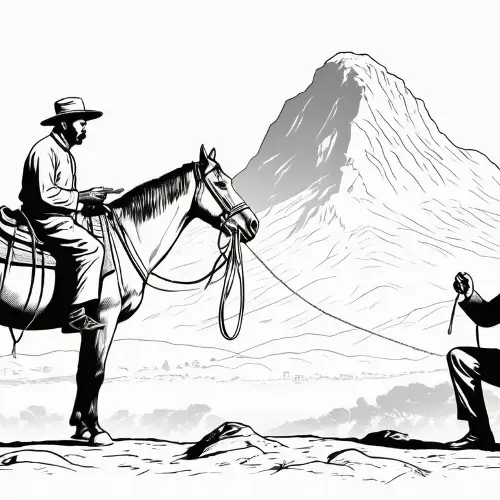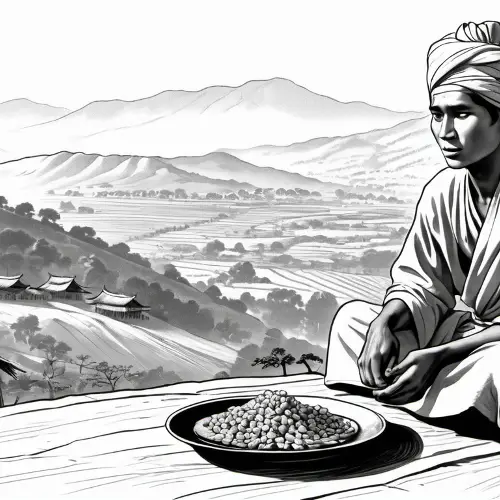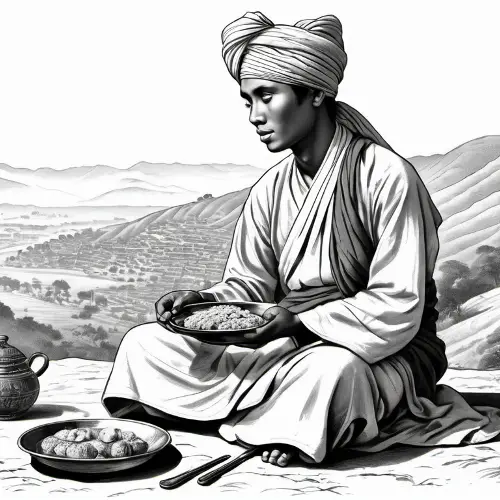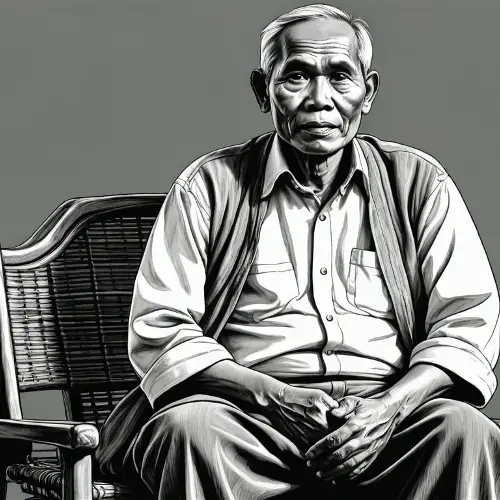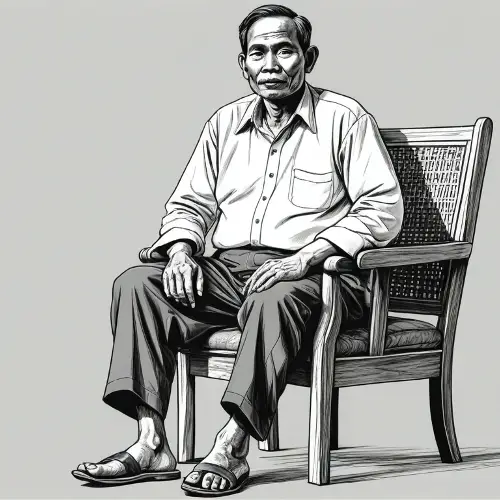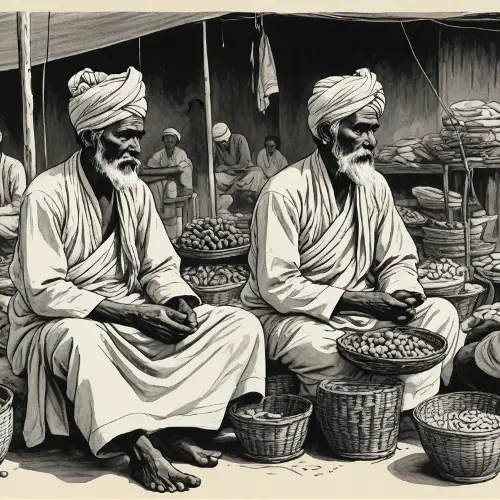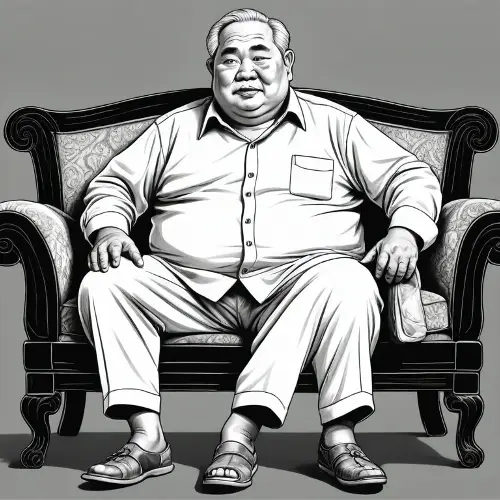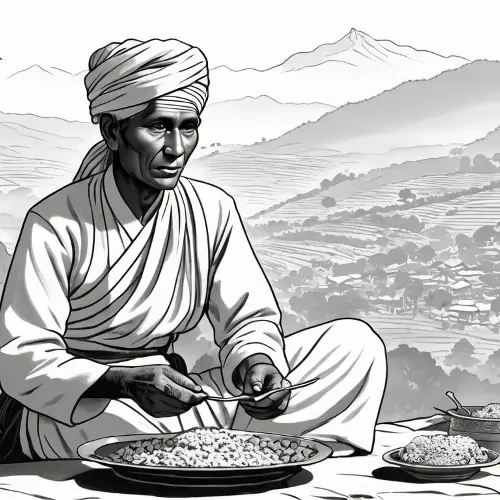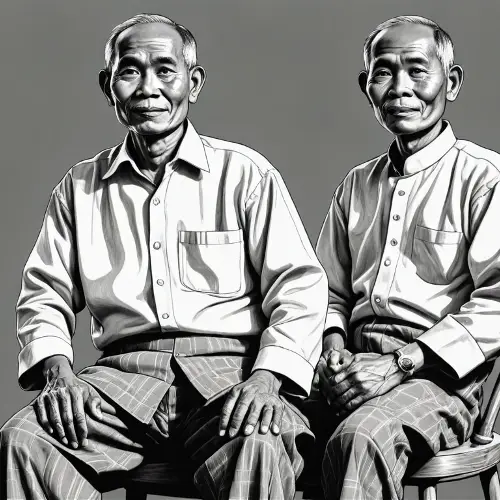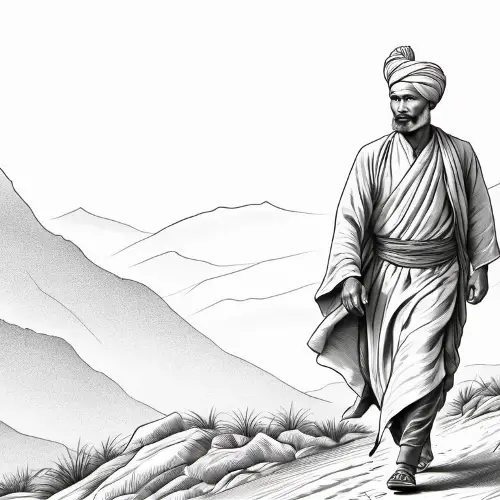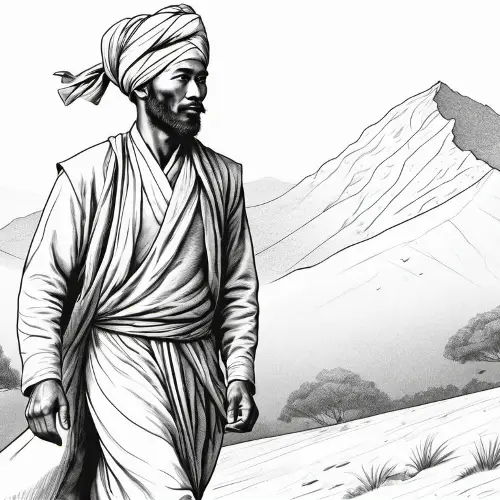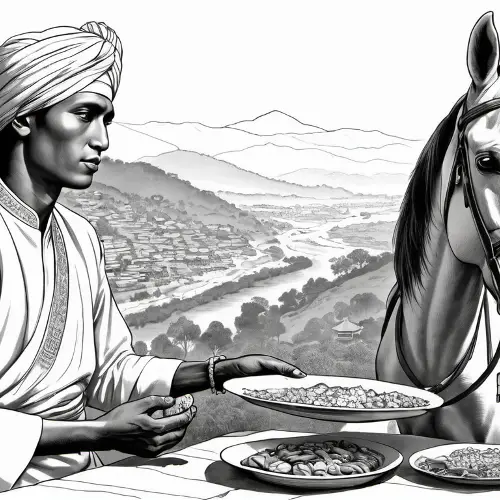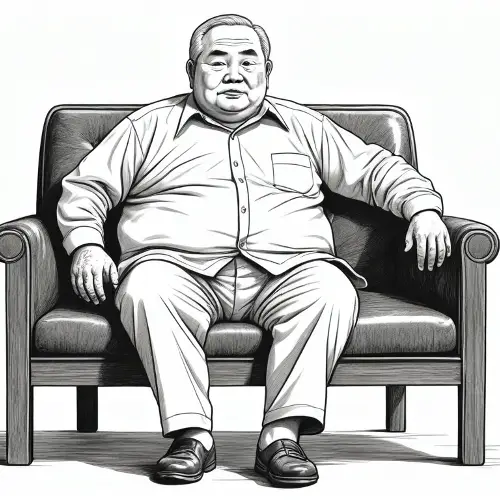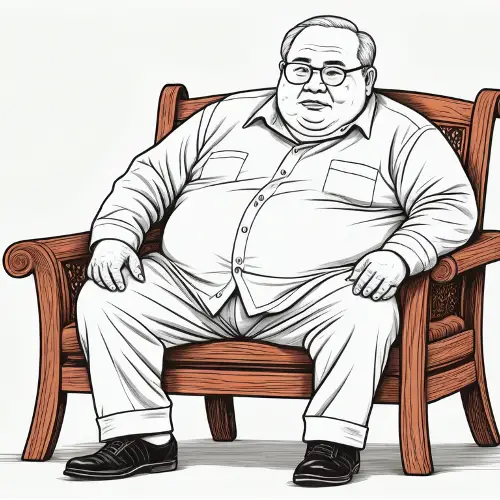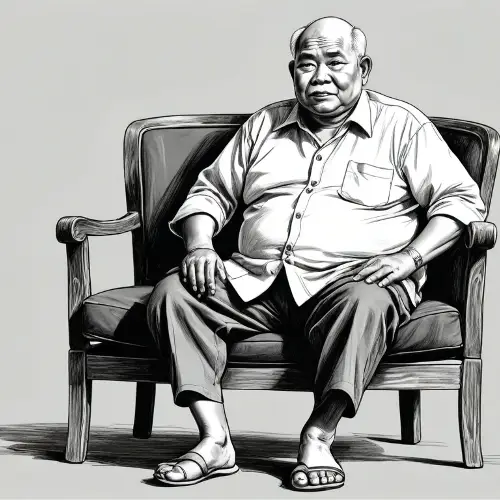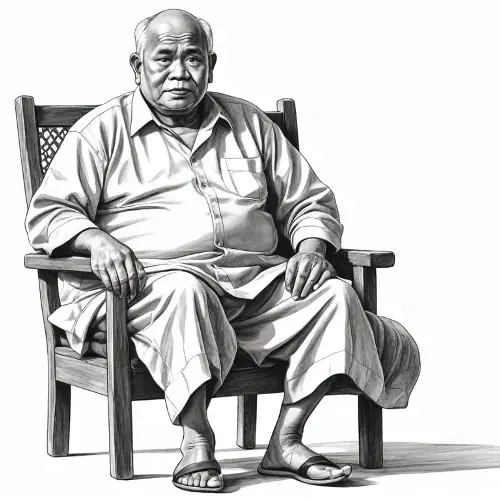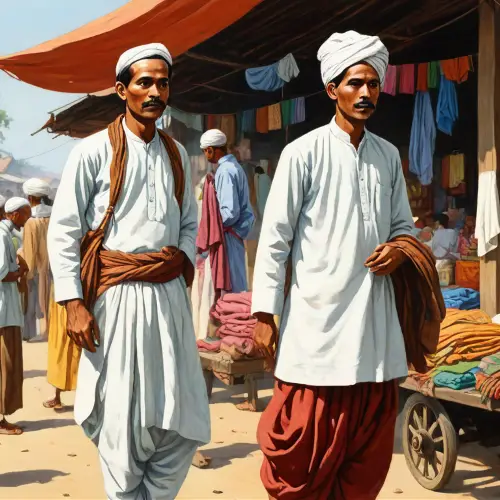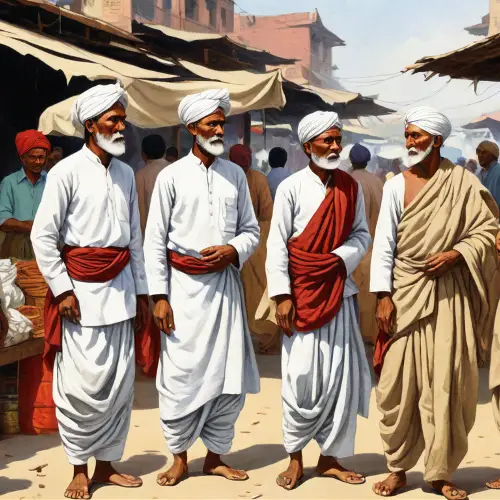Generate an image of a bustling 1940s theater scene in Burma, where the President of Burma stands among a diverse crowd, eagerly watching a captivating performance. The spotlight is on a 13-year-old boy dressed as King Ashoka, delivering a spellbinding theatrical performance, surrounded by intricate props and set pieces that transport the audience to ancient times. Capture the atmosphere of anticipation, cultural richness, and historical resonance in this visually compelling moment. greyscale.
Imagine a scene in the hill area of Burma in the year 1880. A distinguished man is depicted, wearing a traditional turban, kurta, and dhoti, standing with a sense of grace. His attire is detailed, reflecting the cultural nuances of the region during that period. Beside him, a mule is tethered, carrying goods or belongings, adding an element of daily life in the hills. The landscape around is hilly, with lush vegetation and perhaps a glimpse of distant mountains. The man may be holding a piece of luggage or engaged in an activity, further emphasizing the context of life in Burma during the late 19th century.
Imagine a scene in the hill area of Burma in the year 1880. A distinguished man is depicted, wearing a traditional turban, kurta, and dhoti, standing with a sense of grace. His attire is detailed, reflecting the cultural nuances of the region during that period. Beside him, a mule is tethered, carrying goods or belongings, adding an element of daily life in the hills. The landscape around is hilly, with lush vegetation and perhaps a glimpse of distant mountains. The man may be holding a piece of luggage or engaged in an activity, further emphasizing the context of life in Burma during the late 19th century.
Imagine a scene in the hill area of Burma in the year 1880. A distinguished man is depicted, wearing a traditional turban, kurta, and dhoti, standing with a sense of grace. His attire is detailed, reflecting the cultural nuances of the region during that period. Beside him, a mule is tethered, carrying goods or belongings, adding an element of daily life in the hills. The landscape around is hilly, with lush vegetation and perhaps a glimpse of distant mountains. The man may be holding a piece of luggage or engaged in an activity, further emphasizing the context of life in Burma during the late 19th century.
Imagine a scene in the hill area of Burma in the year 1880. A distinguished man is depicted, wearing a traditional turban, kurta, and dhoti, standing with a sense of grace. His attire is detailed, reflecting the cultural nuances of the region during that period. Beside him, a mule is tethered. The landscape around is hilly, with lush vegetation and perhaps a glimpse of distant mountains. The man may be holding a piece of luggage or engaged in an activity, further emphasizing the context of life in Burma during the late 19th century.
In a dimly lit Burmese hospital room in 1885, a Marwadi man lies on a wooden bed with closed eyes, wearing a vibrant turban and covered by an intricately patterned blanket. The atmosphere is serene, with a mix of curious onlookers, patients, and concerned family members surrounding him. A dedicated doctor, dressed in period-appropriate attire, examines a medical chart nearby. The scene captures a multicultural tapestry of Burma in the late 19th century, with soft lighting creating a poignant moment of cultural convergence and compassion.
Imagine an Indian man in the hilly region of Burma in 1880. Hes sitting on a rock or a simple surface, wearing a turban and a traditional doti. The man is depicted enjoying a meal in a serene setting. Beside him, a mule is securely tied, and luggage is neatly arranged, indicating a moment of rest during a journey. The hilly landscape features rugged terrains with greenery and perhaps a glimpse of a winding trail or distant hills. This scene captures a peaceful moment in the daily life of an individual in the hill areas of Burma during the late 19th century.
Envision a scene in the hilly terrain of Burma in the year 1880. A man, adorned in a turban and traditional doti, is seated on a rock or a makeshift surface, savoring a meal. His attire is intricately detailed, reflecting the cultural identity of the region during that period. Beside him, a mule is securely tied, and luggage is neatly arranged nearby, suggesting a pause in a journey or a moment of rest during travel. The hilly backdrop features rugged landscapes, with vegetation and perhaps a glimpse of a winding trail or distant hills. The scene captures a serene moment in the daily life of Burmas hill areas in the late 19th century
Imagine an Indian man in the hilly region of Burma in 1880. Hes sitting on a rock or a simple surface, wearing a MARWADI THIN turban and a traditional doti. The man is depicted enjoying a meal in a serene setting. Beside him, a mule is securely tied, and luggage is neatly arranged, indicating a moment of rest during a journey. The hilly landscape features rugged terrains with greenery and perhaps a glimpse of a winding trail or distant hills. This scene captures a peaceful moment in the daily life of an individual in the hill areas of Burma during the late 19th century.
Illustrate a serene scene within a bustling market in Burma circa 1880, featuring a charming shop with a distinctive bamboo roof. The focus should be on the architectural beauty and simplicity of the bamboo structure, which was a prevalent building material in traditional Burmese construction.
In the dimly lit room of a Burmese hospital in the year 1885, a Marwadi man lies peacefully on a wooden bed, his eyes closed as if lost in the realms of slumber. The atmosphere is hushed, with only the faint sounds of distant conversations and the occasional creaking of the wooden floor. The Marwadi man is adorned in traditional attire, wearing a vibrant turban that signifies his cultural identity. The turban is neatly wrapped, its colors muted but still retaining a touch of elegance. The mans face reflects a sense of calmness, perhaps in the midst of recovery or contemplation. A thick blanket covers the Marwadi man, providing warmth in the coolness of the hospital room. The blanket is woven with intricate patterns, showcasing the craftsmanship of the region. Its edges drape gracefully over the sides of the bed. Surrounding the bed are diverse characters, each telling a story of their own. There are curious onlookers, fellow patients, and concerned family members, all with expressions that convey a mix of empathy, hope, and curiosity. The attire of the people varies, representing the multicultural tapestry of Burma in the late 19th century. A wise-looking doctor, dressed in period-appropriate medical attire, stands nearby, examining a medical chart. The doctors face reveals a mix of determination and compassion, suggesting a dedication to the well-being of the patients under their care. The lighting in the room is soft, emanating from a combination of flickering oil lamps and daylight filtering through worn curtains. Shadows dance on the walls, adding depth to the scene. This sketch captures a moment frozen in time, where cultures converge in the heart of a Burmese hospital, and the spirit of compassion transcends the boundaries of time and place.
In the dimly lit room of a Burmese hospital in the year 1885, a Marwadi man lies peacefully on a wooden bed, his eyes closed as if lost in the realms of slumber. The atmosphere is hushed, with only the faint sounds of distant conversations and the occasional creaking of the wooden floor. The Marwadi man is adorned in traditional attire, wearing a vibrant turban that signifies his cultural identity. The turban is neatly wrapped, its colors muted but still retaining a touch of elegance. The mans face reflects a sense of calmness, perhaps in the midst of recovery or contemplation. A thick blanket covers the Marwadi man, providing warmth in the coolness of the hospital room. The blanket is woven with intricate patterns, showcasing the craftsmanship of the region. Its edges drape gracefully over the sides of the bed. Surrounding the bed are diverse characters, each telling a story of their own. There are curious onlookers, fellow patients, and concerned family members, all with expressions that convey a mix of empathy, hope, and curiosity. The attire of the people varies, representing the multicultural tapestry of Burma in the late 19th century. A wise-looking doctor, dressed in period-appropriate medical attire, stands nearby, examining a medical chart. The doctors face reveals a mix of determination and compassion, suggesting a dedication to the well-being of the patients under their care. The lighting in the room is soft, emanating from a combination of flickering oil lamps and daylight filtering through worn curtains. Shadows dance on the walls, adding depth to the scene. This sketch captures a moment frozen in time, where cultures converge in the heart of a Burmese hospital, and the spirit of compassion transcends the boundaries of time and place.
Various people bowing down to the statue of Buddha during 1950 in Myanmar
60 year old man in burma sitting on a traditional burmese chair. charcoal style
60 year old man in burma sitting on a traditional burmese chair. charcoal style
Generate captivating and historically accurate images depicting a man with a turban immersed in the act of eating his food amidst the serene hills of Myanmar in the year 1837. Portray the cultural richness by highlighting the traditional Indian turban and attire against the backdrop of the Myanmar landscape. Pay meticulous attention to historical details, including the mans clothing style, the picturesque hills, and the tied horse nearby. Convey the tranquil and cross-cultural ambiance of the moment, providing a visual narrative of daily life in the Myanmar hills during the 19th century.
55 years old man in burma. wearing lungi and sitting on traditional burmese chair. he is a little fat.charcoal style
oad facing clothing shop in year 1837 in myanmar with bamboo roof and bit crowd
45 years old man in burma. wearing lungi and sitting on traditional burmese chair. he is a little fat.charcoal style
Generate a detailed line art sketch featuring a Marwadi man seated on a Burmese market street in 1887. The man is wearing a traditional turban and dhoti, facing left, and engaged in selling vibrant cloth materials. Capture the intricate details of his attire, the texture of the fabrics on display, and the historical elements of the bustling Burmese market. Illustrate the street scene with architectural nuances and the lively atmosphere of customers exploring the textile offerings. Emphasize the cultural exchange and trade dynamics in this snapshot of 1887 Burma
Creating a black and white line art image requires a visual artist or graphic designer, as it involves translating the described scene into a 2D representation with lines and shading. However, I can provide a simplified textual representation of the scene in a style reminiscent of a black and white line art description: Title: \Vipassana Serenity\ Description: Imagine a sweeping landscape in Myanmar, where a Vipassana meditation center stands as a beacon of tranquility. The retreat is nestled amid rolling hills and framed by the graceful curves of traditional Burmese architecture. Individual meditation rooms dot the scene, each a simple, standalone structure adorned with cultural nuances. Diverse meditators engage in profound introspection within their private sanctuaries. Through open windows and doors, glimpses reveal individuals in varied postures, symbolizing the unity in their solitary pursuit of inner peace. Natural light delicately illuminates the scene, casting shadows that dance across the meditation rooms and the surrounding landscape. Symbolic elements such as lotus flowers and prayer flags add a touch of cultural richness to the image. Harmony with nature prevails, as swaying trees and the gentle ripples of a nearby pond create a serene backdrop. The time of day, whether the soft glow of dawn, the warmth of midday sunlight, or the tranquil hues of dusk, sets the mood for this visual ode to Vipassana meditation.
60 year old little chubby man in burma sitting on a traditional burmese chair. black and white. charcoal style
Generate immersive and historically accurate images portraying an Indian man, adorned with a turban, peacefully enjoying his meal in the scenic hills of Myanmar in the year 1837. Emphasize the cultural blend through the traditional Indian turban and attire against the backdrop of the Myanmar landscape. Pay meticulous attention to historical details, including clothing styles, the picturesque hills, and the horse tied nearby. Convey the harmonious and cross-cultural moment, illustrating the quietude of an individual relishing food in the tranquil beauty of the Myanmar hills during the 19th century.
50 years old burmese man sitting on a traditional burmese chair. he is somewhat chubby. he is wearing traditional burmese lungi. charcoal style
50 years old burmese man sitting on a traditional burmese chair. he is somewhat chubby. he is wearing traditional burmese lungi. charcoal style
Create a series of captivating images featuring a man wearing a turban walking against the strong wind amidst the scenic hills of Myanmar. Emphasize the resilience and determination of the individual facing the elements, with the wind-swept hills providing a dramatic backdrop. Capture the dynamic interaction between the turbaned man and the force of the wind, highlighting the rugged beauty of the Myanmar hills. Pay attention to the details of the landscape, showcasing the unique features of the terrain while conveying a sense of strength and endurance in the face of natures forces
burmese people meditating inside pagoda in a individual cells . all are sitting with eyes closed in their respective small cells . charcoal style, black and white
Generate vivid and historically accurate images depicting an Indian man, donned in a turban, savoring a meal next to his tied horse in the picturesque hills of Myanmar in the year 1837. Capture the cross-cultural tableau, emphasizing the traditional Indian attire against the backdrop of the Myanmar landscape. Pay meticulous attention to historical details, including the intricate design of the turban, clothing styles, and the scenic beauty of the hills. Convey the cultural richness and tranquility of the moment as the man enjoys his meal beside his horse in the historical context of Myanmar in 1837
Create a series of captivating images featuring a man wearing a turban walking against the strong wind amidst the scenic hills of Myanmar. Emphasize the resilience and determination of the individual facing the elements, with the wind-swept hills providing a dramatic backdrop. Capture the dynamic interaction between the turbaned man and the force of the wind, highlighting the rugged beauty of the Myanmar hills. Pay attention to the details of the landscape, showcasing the unique features of the terrain while conveying a sense of strength and endurance in the face of natures forces backside of man
The Burma House Haveli in 1890 was an architectural marvel blending Burmese and Indian styles. The exterior featured intricate carvings depicting mythical creatures and folklore scenes. The lush courtyard housed vibrant gardens, creating a serene atmosphere. Inside, teak wood furniture, tapestries, and murals adorned opulent rooms, showcasing a cosmopolitan fusion. The haveli served as a cultural hub for gatherings, fostering intellectual exchange. As the sun set, lanterns illuminated the majestic facade, reflecting the sophistication and elegance of a bygone era.
60 year old little chubby man in burma sitting on a traditional burmese chair
burmese people meditating inside pagoda. all are sitting with eyes closed. charcoal style, black and white
50 years old burmese man sitting on a traditional burmese chair. he is chubby and have a long face with litle short dark hairs. he is wearing traditional burmese lungi. charcoal style
60 year old little fat man in burma wearing lungi and sitting on a traditional burmese chair. charcoal style.
principal of a sikh khalsa school talking to one man in his office. year is 1930 in Burma country.
Create a sketch capturing the cultural fusion in a bustling market scene in Burma circa 1880. Focus on a Marwadi man, dressed in a traditional dhoti and kurta, actively engaged in selling cloth materials. The man could be showcasing vibrant textiles characteristic of Marwadi culture. Detail the merchants attire, paying attention to the intricacies of the dhoti and kurta, as well as any accessories that might signify his cultural background. Emphasize the array of fabrics and textiles displayed in his stall of the cloth trade during that era. Surround the Marwadi cloth merchant with the diverse sights of the market – other stalls, customers exploring, and perhaps fellow merchants. Incorporate architectural elements of the market, suggesting the traditional structures and ambiance of a Burmese market in the late 19th century




















